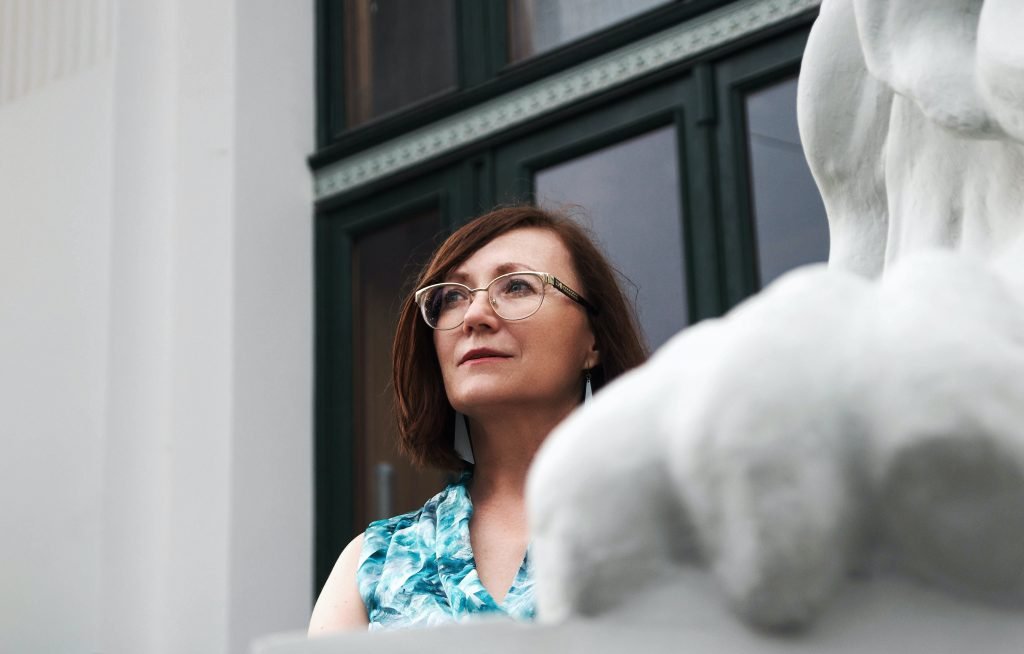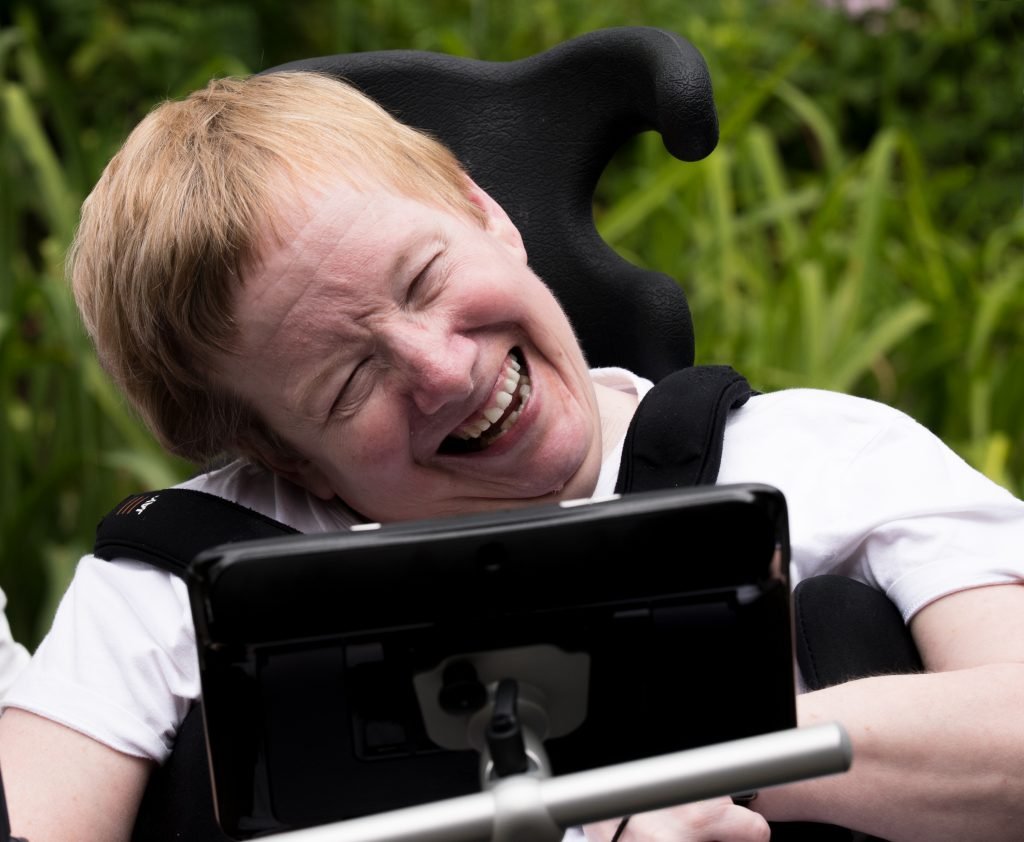Myth:
Expressing basic needs is enough
Communicating with the help of assisted communication

Individuals who use assisted communication systems use multiple methods to convey a message , depending on the situation and/or the communication partner. Their assisted communication system may include a communication device, a communication board/book, and non-verbal communication methods such as:
- Body language (muscle tension that shows frustration or a shrug of the shoulders as an expression of disappointment)
- Showing (showing certain objects, people or places in your environment, as well as showing instructions)
- Gesturing (patting the stomach to indicate hunger, touching the head as a sign of a headache)
- Facial expressions (frowning as an expression of sadness or smiling as an expression of pleasure)
Some people will also vocalize or use speech in the process of communication, depending on how developed or preserved it is.
Using assisted communication in combination with speech
Many users of assisted communication have a partial ability to speak, but it is important to ask yourself the following:
- Is their speech functional enough to participate in everyday activities?
- Does their speech enable them to learn and develop language skills?
Let's look at this from two different points of view - that of a child with autism spectrum disorder who is just developing their speech, and that of an adult with aphasia who is learning to speak again.
Ivan is a boy with an autism spectrum disorder. He attends the second grade of elementary school. He uses limited speech, some gestures and pointing to indicate his basic needs. When such methods do not prove successful, he takes someone's hand and leads him to what he wants. Also from time to time he suddenly repeats a sentence from his favorite television series or a word, phrase or sentence that someone has said.

Can Ivan, with the help of his current language and speaking skills, master the school material and expand his language knowledge? Is his speech functional enough to enable him to participate in daily life activities?
At the moment, he can hardly say what he wants to say. He has difficulty in social interaction because he cannot tell funny stories or tell anything about himself. He can answer questions with "yes" or "no", but has difficulty with other questions and participates in school activities to a limited extent. As he grows, we expect him to be more independent in taking care of his personal needs, but we do not know if and when his speech, gestures and pointing will be in line with his social needs.
Tanja is a woman with aphasia, a language disorder that is most often caused by a stroke. She can make coffee, take food, go to the toilet and take a blanket if she is cold. She can dress herself and physically take care of her daily needs, as well as the needs of her family.
However, he has a hard time finding the words he wants to say. Her messages are mostly "telegraphic". They'll say, for example, "Shop... today," and then point to the fridge. He will also try to draw something or write a few letters to convey his message more easily.

Photo by Maria Lupan on Unsplash
Is Tanya's speech functional enough to be able to participate in everyday activities?
Tanja has two teenage daughters and has been married for 25 years. With his current speech abilities, he has difficulty telling people what he wants, has difficulty expressing his feelings or talking about his life, has difficulty asking questions, does not make it clear what he is thinking, has difficulty participating in activities typical of adults (e.g. paying bills, ordering from restaurant, shopping).
Using only speech, Tanja and Ivan will find it difficult to communicate when they need to tell something, express their opinion, achieve social interaction with their colleagues and/or develop language and literacy at a higher level. Assisted communication can help both Tanja and Ivan to communicate much more than basic needs!
Purpose of communication - more than basic needs
The satisfaction of basic needs is, by definition, crucial for our physical well-being, whether we have satisfied them ourselves (e.g. we made ourselves a sandwich or defecated), or whether we expressed them to others to do it for us (e.g. we asked something to eat or ask for help with defecation). Failure to meet basic needs can result in illness, injury, pain, abuse, negligence, medical intervention, hospitalization, and possibly death. In no way do we want to downplay the importance of providing for these needs, whether individuals can meet them on their own or with the help of others.
However, expressing basic needs is not the only reason why we communicate . Think back to the last phone conversation you had with a friend or lunch with your family. Were you just relaying information about your basic needs, or were you sharing updates about your work day or school day? Maybe you talked about the summer vacation, about the latest movie or how the traffic jam drove you crazy. Light (1996) lists four purposes of communication :
- Desires and needs - this includes expressing the basic needs that we previously defined, as well as individual desires (eg television, music, a hug or rest).
- Information transfer – sharing information (eg how to change a tire on a car, directions to someone's house, answering questions at school, giving directions to a colleague at work or carer).
- Behavioral rules - socially acceptable greetings, words and phrases (eg thank you, please or you're welcome).
- Social closeness – messages that facilitate the initiation or maintenance of social relationships (eg stories, asking questions, compliments or feedback).

Photo by Duy Pham on Unsplash
We can see that communication is much more than just expressing basic needs! If you are a parent, a student, a colleague at work, an employer, you might say that "information transfer" makes up most of your communication, directing others to something, and sharing information. Communication with family members and friends often has the purpose of social closeness - deepening our relationships. When we are in a public place, rules of conduct play an important role in our interactions. Expressing wants and needs is certainly part of what we share with each other, but it is not all of our mutual communication, just as it is not all that people with complex communication needs want to communicate.
How can assisted communication help?
As we mentioned at the beginning, assisted communication is only one part of a person's overall communication system, which can include a communication device, gesturing, pointing, drawing and natural speech.
Assisted communication serves as a means of:
- List Item #3more understandable communication,
- expressing the exact message that one wants to convey,
- interactions with unknown people,
- sharing messages that are not part of normal routines,
- communication with more independence,
- because of which people will perceive the person as a competent interlocutor,
- participation in longer and better interactions,
- expansion of language and communication skills.
There is no evidence that the use of assisted communication will prevent a person from using their natural speech. Assisted communication will provide equal opportunities for communication to those people who have difficulties in speech and language. In this way, they will be able to establish social ties and closeness with others. Through the use of assisted communication, they will more easily control their environment, acquire language and literacy, communication partners will consider them competent, and the number of opportunities for communication will increase , such as these:
- With the help of programmed messages about how she spent the weekend, Maja was able to share the exciting moments of camping with her family with her class. She also showed them pictures from camping on her communicator.
- Guests called Mrs. Horvat and said they would stop by because they were passing through town. With the help of a communicator, writing and speaking, she informed her husband about it.
- Andrej knew the answer to the question in nature class. He raised his hand and answered with the help of a communication device.
- Luka's sister moved to another country. With the help of the communicator, Luka could call her and thus continue their weekly conversations.
- In his spare time, Ivan, with the help of his communicator, organized the construction of a tree house with his classmates.
- Tanja was able to participate in the parents' meeting at her daughter's school.

Photo by Tobii Dynavox
Assisted communication can encourage involvement and independence in all environments and with different communication partners, and thus lead to greater satisfaction with one's own life!
LITERATURE
Light, J. (1996). Communication is the essence of human life. Augmentative and Alternative Communication, 13 , 61-70.

